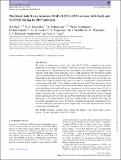Files in this item
The black hole X-ray transient Swift J1357.2-0933 as seen with Swift and NuSTAR during its 2017 outburst
Item metadata
| dc.contributor.author | Beri, Aru | |
| dc.contributor.author | Tetarenko, B. E. | |
| dc.contributor.author | Bahramian, A. | |
| dc.contributor.author | Altamirano, Diego | |
| dc.contributor.author | Gandhi, Poshak | |
| dc.contributor.author | Sivakoff, G. R. | |
| dc.contributor.author | Degenaar, N. | |
| dc.contributor.author | Middleton, M. J. | |
| dc.contributor.author | Wijnands, R. | |
| dc.contributor.author | Hernández Santisteban, J. V. | |
| dc.contributor.author | Paice, John A. | |
| dc.date.accessioned | 2019-09-11T10:30:04Z | |
| dc.date.available | 2019-09-11T10:30:04Z | |
| dc.date.issued | 2019-05 | |
| dc.identifier | 261033197 | |
| dc.identifier | 3ef21242-9467-43aa-8c1d-5290af304176 | |
| dc.identifier | 85063159634 | |
| dc.identifier.citation | Beri , A , Tetarenko , B E , Bahramian , A , Altamirano , D , Gandhi , P , Sivakoff , G R , Degenaar , N , Middleton , M J , Wijnands , R , Hernández Santisteban , J V & Paice , J A 2019 , ' The black hole X-ray transient Swift J1357.2-0933 as seen with Swift and NuSTAR during its 2017 outburst ' , Monthly Notices of the Royal Astronomical Society , vol. 485 , no. 3 , pp. 3064-3075 . https://doi.org/10.1093/mnras/stz616 | en |
| dc.identifier.issn | 0035-8711 | |
| dc.identifier.other | BibCode: 2019MNRAS.485.3064B | |
| dc.identifier.other | ORCID: /0000-0002-6733-5556/work/61370249 | |
| dc.identifier.uri | https://hdl.handle.net/10023/18460 | |
| dc.description.abstract | We report on observations of black hole Swift J1357.2–0933, a member of the modest population of very faint X-ray transients. This source has previously shown intense dips in the optical light curve, a phenomena that has been linked to the existence of a ‘unique toroidal structure’ in the inner region of the disc, seen at a high inclination. Our observations, carried out by the Neil Gehrels Swift and NuSTAR X-ray observatories, do not show the presence of intense dips in the optical light curves. We find that the X-ray light curves do not show any features that would straightforwardly support an edge-on configuration or high inclination configuration of the orbit. This is similar to what was seen in the X-ray observations of the source during its 2011 outburst. Moreover, the broad-band spectra were well described with an absorbed power-law model without any signatures of cut-off at energies above 10 keV, or any reflection from the disc or the putative torus. Thus, the X-ray data do not support the unique ‘obscuring torus’ scenario proposed for J1357. We also performed a multiwavelength study using the data of X-ray telescope and Ultraviolet/Optical Telescope aboard Swift, taken during the ∼4.5 months duration of the 2017 outburst. This is consistent with what was previously inferred for this source. We found a correlation between the simultaneous X-ray and ultraviolet/optical data and our study suggests that most of the reprocessed flux must be coming out in the ultraviolet. | |
| dc.format.extent | 1096969 | |
| dc.language.iso | eng | |
| dc.relation.ispartof | Monthly Notices of the Royal Astronomical Society | en |
| dc.subject | Accretion | en |
| dc.subject | Accretion discs | en |
| dc.subject | Black hole physics | en |
| dc.subject | Stars: black holes | en |
| dc.subject | X-rays: binaries | en |
| dc.subject | X-rays: individual: Swift J1357.2-0933 | en |
| dc.subject | QB Astronomy | en |
| dc.subject | QC Physics | en |
| dc.subject | DAS | en |
| dc.subject.lcc | QB | en |
| dc.subject.lcc | QC | en |
| dc.title | The black hole X-ray transient Swift J1357.2-0933 as seen with Swift and NuSTAR during its 2017 outburst | en |
| dc.type | Journal article | en |
| dc.contributor.institution | University of St Andrews. School of Physics and Astronomy | en |
| dc.identifier.doi | 10.1093/mnras/stz616 | |
| dc.description.status | Peer reviewed | en |
| dc.identifier.url | https://arxiv.org/abs/1903.00146 | en |
| dc.identifier.url | http://adsabs.harvard.edu/abs/2019MNRAS.485.3064B | en |
This item appears in the following Collection(s)
Items in the St Andrews Research Repository are protected by copyright, with all rights reserved, unless otherwise indicated.

